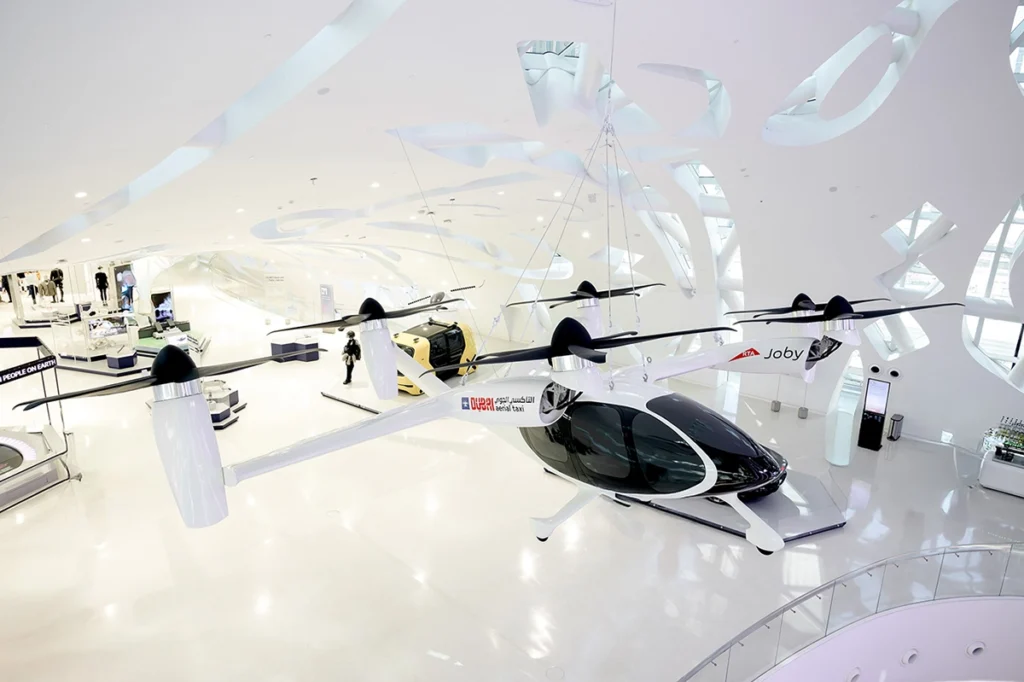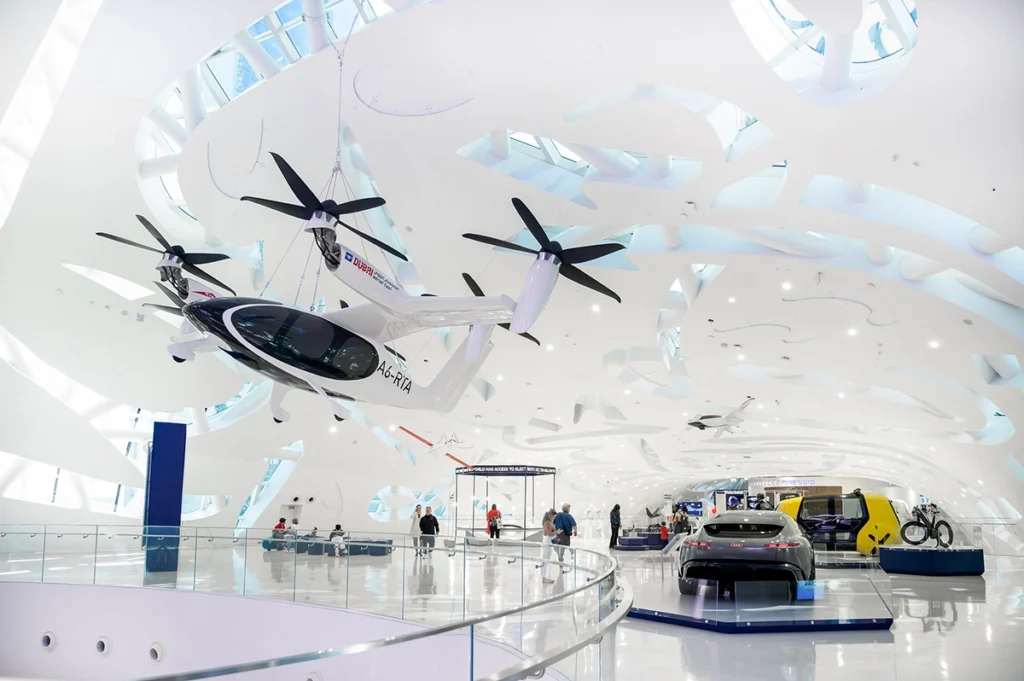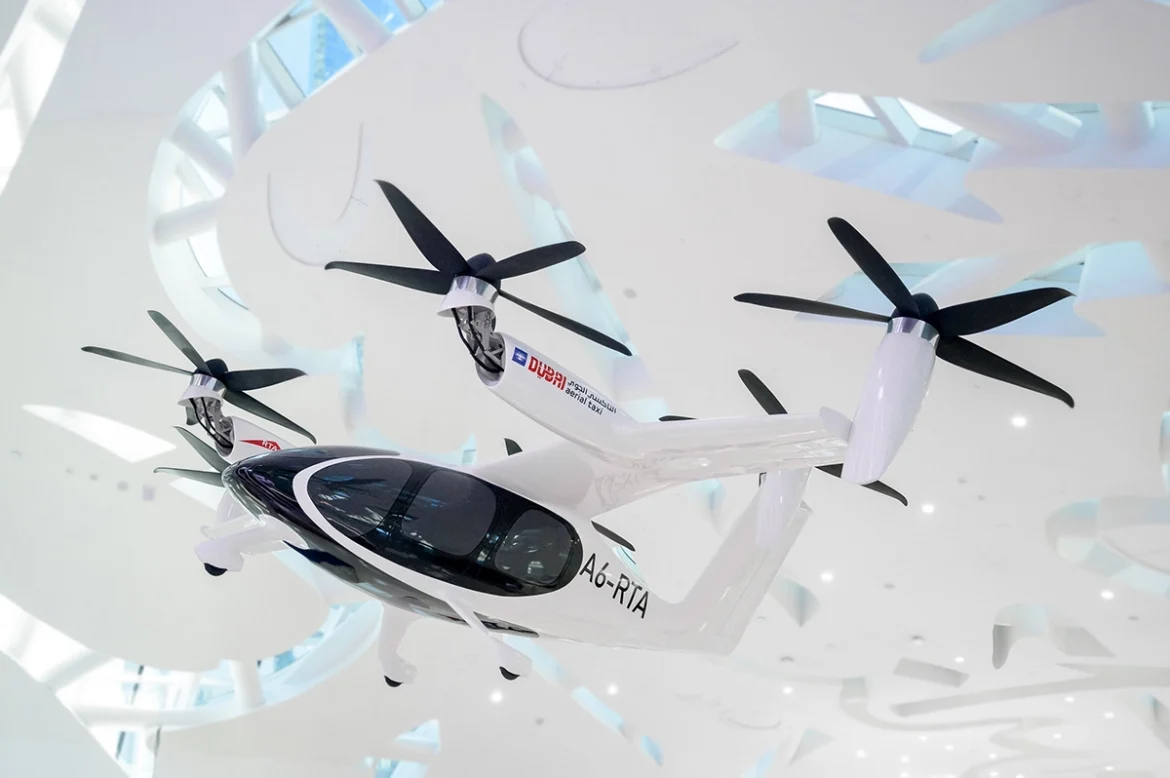Dubai is set to redefine urban travel with the unveiling of its aerial taxi prototype, displayed at the Museum of the Future. Developed by Joby Aviation and showcased in partnership with the Roads and Transport Authority (RTA), this cutting-edge electric vehicle gives a glimpse into the future of smart, sustainable mobility.
The futuristic taxi, which can take off and land vertically, promises to transform how people move around the city, reducing both travel times and carbon emissions.
Expected to launch in 2026, the aerial taxi service will initially connect key locations like Dubai International Airport, Downtown Dubai, Dubai Marina, and Palm Jumeirah. A journey from the airport to Palm Jumeirah, for instance, will take just 12 minutes—compared to the usual 45-minute car ride. With a top speed of 322 km/h and a range of 161 kilometers, the taxi offers a fast, quiet, and eco-friendly alternative to traditional helicopters and taxis.
Key Features of the Dubai aerial taxi
- Electric Power & Zero Emissions: The Joby S4 aerial taxi is fully electric, producing zero harmful emissions and promoting sustainable travel.
- Vertical Takeoff and Landing (VTOL): Unlike traditional aircraft, the aerial taxi can take off and land vertically, making it ideal for busy urban environments with limited space.
- Speed and Efficiency: Capable of reaching speeds of up to 322 km/h, the aerial taxi offers a quick way to bypass city traffic and long commutes.
- Passenger Capacity: The taxi can carry up to four passengers, plus a pilot, providing a convenient and private travel experience.
- Quiet and Comfortable: With six rotors and advanced battery technology, the aerial taxi is significantly quieter than conventional helicopters, making it a more pleasant travel option.
Transforming Dubai’s transportation landscape
The aerial taxi is a key part of Dubai’s ambitious transportation plans, which include the goal of achieving 25% self-driving trips by 2030. This project is a major step towards reducing traffic congestion, improving connectivity, and supporting the city’s sustainability objectives.

The service will not only cut travel times but also integrate seamlessly with other public transport options, such as the metro, buses, and e-scooters, creating a smooth, multimodal travel experience for passengers. By linking major transport hubs and iconic landmarks across Dubai, the aerial taxi will be a game-changer for the city’s residents and visitors alike.
Dubai’s First Vertiport: An advanced hub for aerial travel
Along with the aerial taxi service, Dubai will also introduce its first vertiport—a specialized facility for aerial taxis. This vertiport will be capable of handling 42,000 landings annually and serving around 170,000 passengers. Equipped with state-of-the-art facilities, it will meet the highest global safety standards.
Joby Aviation will oversee the operation of the aerial taxis, while Skyports Infrastructure will handle the design, construction, and operation of the vertiport. RTA will ensure smooth integration with Dubai’s overall transport network. The first vertiport is expected to open in conjunction with the taxi service in 2026.
Khaled Al Awadhi, Director of Transportation Systems at RTA’s Public Transport Agency, shared his excitement for the project: “We are honoured to showcase the aerial taxi model at the Museum of the Future, which underscores Dubai’s ambition and forward-thinking approach to redefining mobility in this vibrant city. Marking the beginning of a transformative era in urban mobility, Dubai is set to become the first city in the world to launch the aerial taxi project, with the service scheduled to commence in the first quarter of 2026. The aerial taxi stands out for its vertical take-off and landing capabilities, coupled with its adherence to the highest standards of safety and security to ensure the well-being of passengers.”

Majed Al Mansoori, Executive Director of the Museum of the Future, added: “The Museum of the Future has become home to the aerial taxi prototype, reflecting Dubai’s pioneering leadership in shaping the future of transportation. This initiative provides visitors with a glimpse into innovations designed to redefine mobility, making travel faster, safer, and more sustainable.” He further explained: “Our partnership with the RTA underscores the museum’s mission to inspire groundbreaking ideas and foster a culture of innovation. It aligns with Dubai’s vision of achieving meaningful advancements that benefit society, guided by the aspirations of our leadership.”
The Future of air travel
Anthony Khoury, UAE General Manager of Joby, expressed his excitement about bringing the aerial taxi prototype to Dubai, saying: “It is an honour to share our electric air taxi with the public through this exhibit, at a museum that is committed to advancing a more sustainable future for all. We plan to deliver an incredible experience for residents and visitors to Dubai, and we’re excited to invite people into the conversation about what the future of clean, quiet and efficient air travel will look like when we launch our service.”
The aerial taxi is also a critical component of Dubai’s Self-Driving Strategy, complementing other autonomous modes of transport like the metro, buses, and taxis. This project builds on Dubai’s partnerships with Joby Aviation and Skyports Infrastructure, marking a global first in urban air transport with advanced vertical take-off and landing vehicles.
Dubai’s aerial taxi initiative is a significant milestone in the city’s journey to revolutionize urban mobility. By blending cutting-edge electric aviation technology with a focus on sustainability, safety, and efficiency, Dubai is paving the way for a smarter, greener, and more connected future. With the launch of the aerial taxi service scheduled for 2026, Dubai is setting the stage to become a global leader in innovative, eco-friendly transportation solutions.
tanvir@dubainewsweek.com

